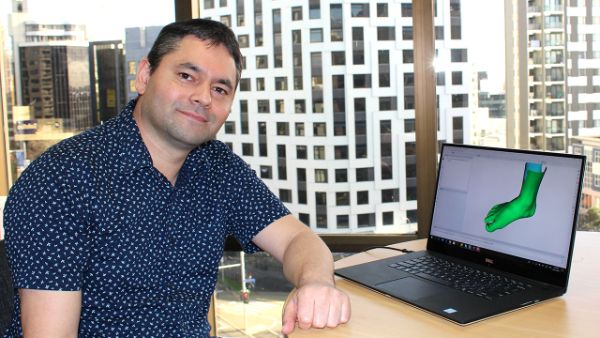Getting To The Heart And Sole Of Barefoot Running
Were we really born to run barefoot, and even if we were, should we try to revert to nature after a lifetime of wearing shoes?
Probably not all of us, according to research led by Associate Professor Justin Fernandez, Auckland Bioengineering Institute (ABI), University of Auckland.

It depends on the shape of our feet, and whether we grew up wearing shoes or not, and how experienced we are as runners.
Dr Fernandez approaches running biomechanics using computational models, motion analysis and medical imaging to investigate how our feet adapt to barefoot running.
Working with collaborators in Ningbo University, China, Dr Fernandez has shown that the shape and alignment of our toes changes the distribution of pressure on our feet, and this is likely to have considerable impact on how we adjust to barefoot running.
The shape of our feet is likely to be influenced by how we grew up. “If you grew up not wearing shoes, your toes are less constrained and you will likely have a large space between your big toe and your other toes”.
He and his colleagues analysed naturally barefoot people in a motion lab. They found that naturally barefoot people placed more pressure on the ball of their feet when they ran, than people who had always worn shoes.
A large toe spacing appears to be associated with a greater forefoot pressure, often observed in barefoot running. That is, they tend to run with a fore-front strike pattern, as opposed to a heel-first running style. As a consequence, people with a big toe spacing might have muscles and bones better adapted to barefoot running.
His research has also shown that experienced runners are more likely to adapt to barefoot running, whether or not they grew up wearing shoes. Working with colleagues from Auckland University School of Medicine, he and his colleagues studied 20 joggers who tried barefoot running for the first time. They looked at each runner’s ankle cartilage using fMRI to detect changes in fluid.
“We found that amateur runners showed significantly increased ankle cartilage fluid after barefoot running for 5km, whereas experienced runners did not,” says Dr Fernandez. “Experienced runners showed less ankle cartilage inflammation after trying barefoot jogging for the first time.”
The vogue for barefoot running
can be traced back to evolutionary biologist, Daniel
Lieberman, after he published a study in Nature in
2004, in which he argued that running like our unshod
ancestors made us less prone to injury than running in
trainers.
Lieberman went on to publish a book about it,
Born to Run, which prompted runners all over the
world to dump the trainers, and inspired the rise of the
‘minimalist shoe’ made of lighter weight than other
running shoes, allowing for more sensory contact between the
foot and the ground.
“There is much research focussed on the running foot strike pattern” says Dr Fernandez. People who have always worn joggers generally land on their heel when running, but the shock is absorbed by the shoes. People who run barefoot or with minimalist shoes may land on the balls of their feet and the impact shock on their joints is reduced. Studies also show that forefoot runners have stronger calf muscles and thicker bone density in the heel of their foot.
“It sounds counterintuitive that if you are not landing on the heel of your foot that your heel bone density would be stronger, but it is due to your stronger calf muscles pulling on your bones that makes them stronger.”
”Our studies have shown that someone’s foot shape, whether they’ve worn shoes or not all their life, and their running experience, should be considered when you are thinking about trying barefoot running.
“If not, your bones and muscles are going to experience a load that they haven’t, before. Your foot shape and running experience will play a role in how quickly you adapt.”


 Vegetables New Zealand: Asparagus Season In Full Flight: Get It While You Still Can
Vegetables New Zealand: Asparagus Season In Full Flight: Get It While You Still Can  Bill Bennett: Download Weekly - How would NZ telecoms cope with another cyclone
Bill Bennett: Download Weekly - How would NZ telecoms cope with another cyclone NZ On Air: Firm Audience Favourites Lead NZ On Air Non-Fiction Funding
NZ On Air: Firm Audience Favourites Lead NZ On Air Non-Fiction Funding Insurance and Financial Services Ombudsman: Woman Gets $40k More After Disputing Insurer’s Decision
Insurance and Financial Services Ombudsman: Woman Gets $40k More After Disputing Insurer’s Decision BNZ: A Quarter Of Older NZers Fear Going Online Due To Scam Concerns
BNZ: A Quarter Of Older NZers Fear Going Online Due To Scam Concerns University of Auckland: Scientists Develop Tool To Monitor Coastal Erosion In Fine Detail
University of Auckland: Scientists Develop Tool To Monitor Coastal Erosion In Fine Detail



